#ætani
Text
Conlang notes made just after midnight 1½ weeks ago

Transcript of notes; addenda not found in original text enclosed in square brackets:
mentally 14 April 2021/14 Ara 3384
technically 15 April 2021/15 Ara 3384
[I can’t stand not having the dates on which I think of new ideas/new characters, mainly because I didn’t keep records of that stuff when I started this series and I now regret that.]
Middle Ætani (maybe also old):
SVO
SObject Pronoun V [The word order is Subject, Verb, Object in most instances, but you can also replace an indirect (like “to me” in “they talk to me”) or a direct object (like me in “they see me”) with a pronoun and put it before the verb. For now, I only have the direct object pronouns figured out for Ætani.]
Lita ider instern sèr Ætani Thækratheu.
She can understand the Ætani Middle [literally: she can understand Middle Ætani.]
Lita ider mu instern. [She can understand him, or in this case, it.]
Direct Object Pronouns:
(m)il (that, as in “that frog over there”) + nom[inative] ending
Ætani: masculine noun (sèr æd tanit)
[Æd /ed/, meaning “word,” is a masculine singular noun. The name of the language is a truncated form of the expression sèr æd tanit, which translates to “the word [that is] read.” Because of this, the name Ætani, which inexplicably loses its final -t despite apocope not being a regular phenomenon at this stage, is a masculine noun.]
SING. PL.
M mu mi
F ma mæ
N mav mà
[Now, I was trying to come up the word for “middle” as in “Middle Ages” or “Middle English” for the sake of the example sentence. I tried using kareu, the masculine singular form of the adjective kareav, but it’s mainly used in the sense of “central” rather than that of “intermediary; in between.” So I had to create a new word for that.]
kravthe- age (as in, years.) [pronounced /krau̯.θə/]
althe- era [pronounced /al.θə/]
a root for history: a middle era; between the old period* (kralthe; [derived from] kravthe and althe) and the modern one (ranikravthe; [derived from rani (now) and kravthe, though maybe it should be ranalthe, or the now era.])
ranikratheav- modern
kraltheav- ancient
Intermediary
/θen/ thæn (between); forms minimal pair with /fen/ (“to trust,”) /ren/ (“to doubt”) and /men/ (“to cast terror”).
thækratheav [or again, maybe thænaltheav /θen.al.θi.au̯/ (between era) would be more appropriate. At any rate, it is the Ætani word I will now use to describe an intermediary stage in history or a language.]
[Also, for no reason:]
/lyn/ to answer (lun)
/løn/ why (lùn)
#ade#conlang#notes#languages#language#pronouns#pronunciation#syntax#maybe also#morphology#and#phonetics#ipa#international phonetic alphabet#that is#ætani#history#object
1 note
·
View note
Text
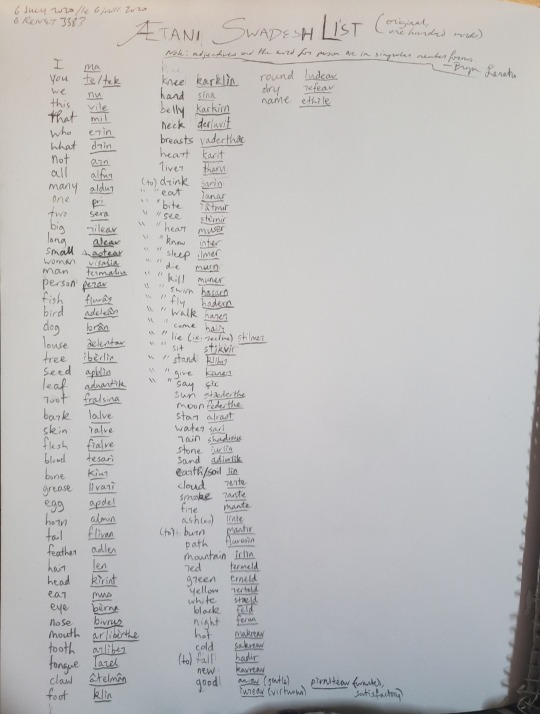
The complete Middle Ætani Swadesh list (the Middle Ætani period lasting from 815 to the end of Iremu.)
#ade#ætani#conlang#list#swadesh list#vocabulary#satv#essentially a list of one hundred basic words#yeah#bryn out#language#languages#maybe not#glottochronology
1 note
·
View note
Text
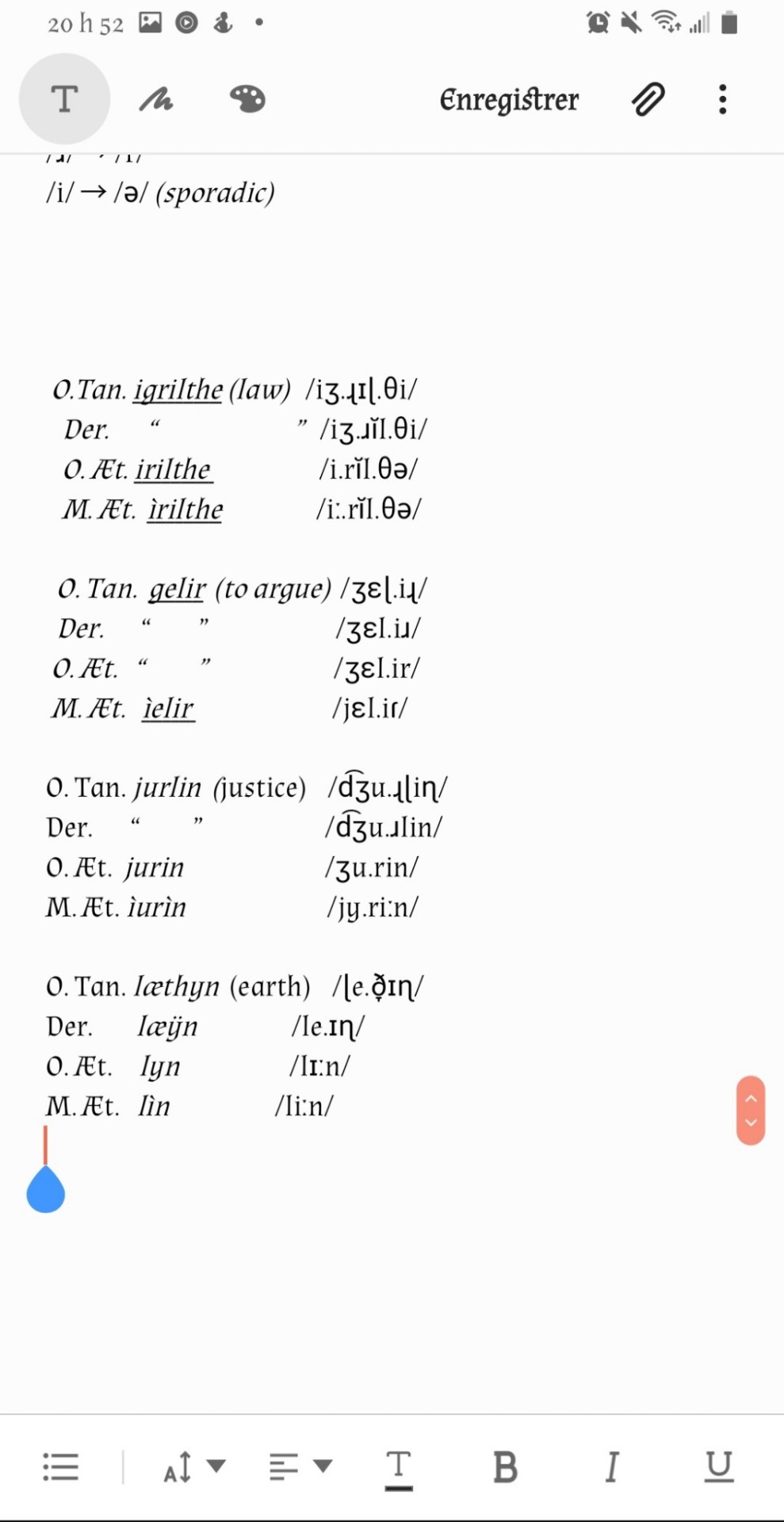
A couple notes on pronunciation throughout the centuries.
Notes:
O. Tan. = Old Tansyd
Der. = Dertani
O. Æt. = Old Ætani
M. Æt. = Middle Ætani
#ade#ætani#conlang#pronunciation#ipa#languages#language#compensatory lengthening#lenition#yada yada#blah#blah blah#whatever#sound changes galore#evolution#yeah
1 note
·
View note
Text
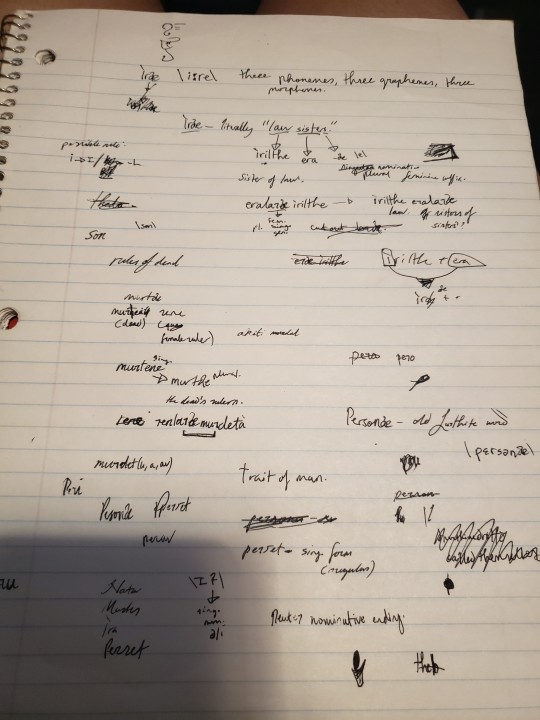
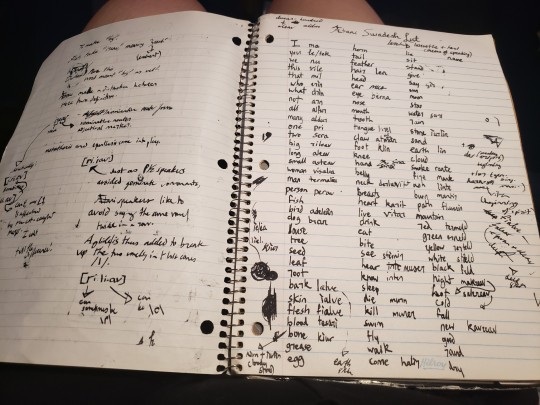
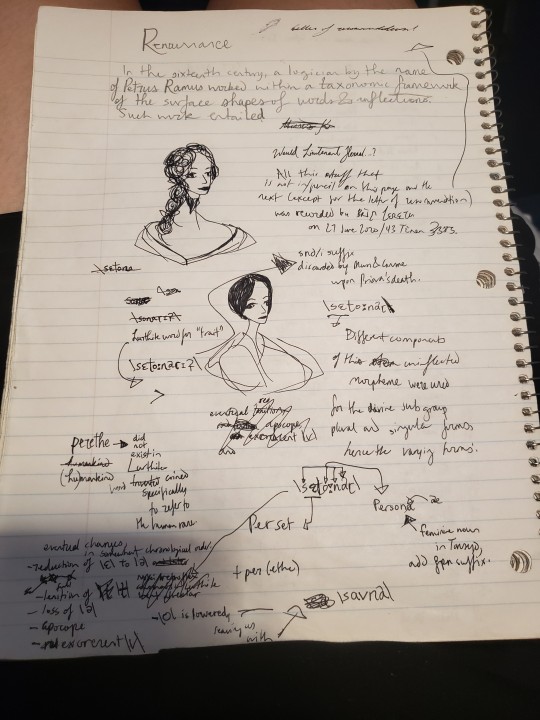
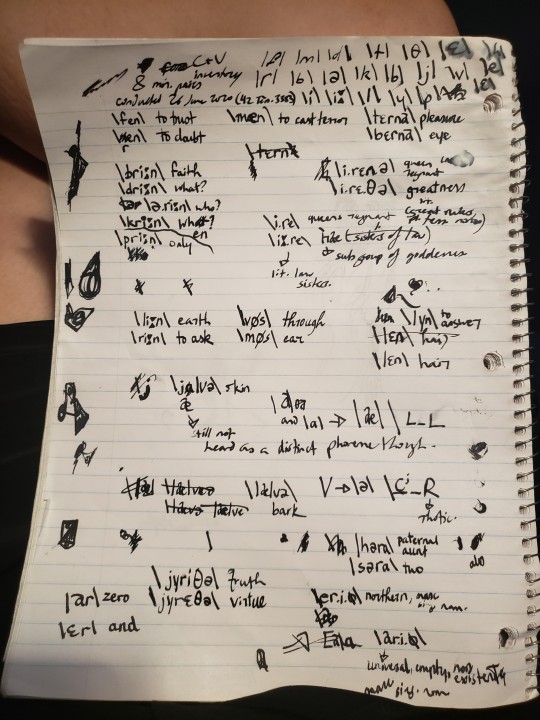

Here’s notes I made yesterday and today on Ætani (/e.tʰɑ̃.i/), one of my conlangs. There’s etymologies, sound changes, sound rules, a complete consonant inventory, insanely lopsided vowels, minimal pairs, doodles, ink smudges and an incomplete Swadesh list.
#conlang#languages#writing#writeblr#ætani#ade#maybe even linguistics?#conlangs#stuff#bi for now#sincerely bryn
0 notes
Text
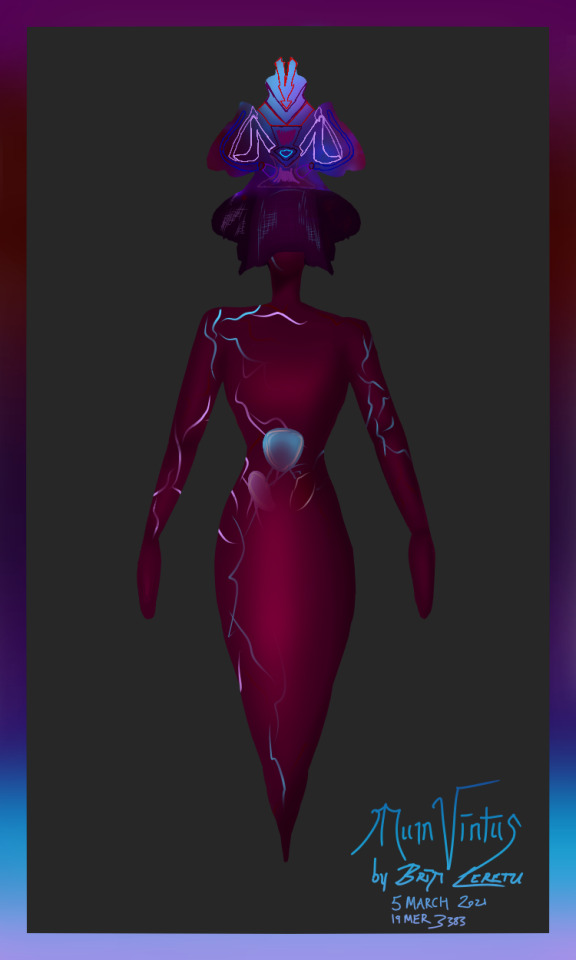
Murn Vīntus (Middle Ætani pronunciation: /myrn.viːn.tys/), the omniscient twin brother of Cosme Vīntus. Known as the Ara Murtea (lit. Dead Universe; usually translated to “Universe of the Dead,” though that would technically be Ara Murtetlavrà), he is more than the mere underworld (the three realms of the dead are represented by some of his internal organs.) Rather, he represents the immaterial plane of existence throughout ADE, as opposed to Cosme, the Living Universe and the physical plane.
2 notes
·
View notes
Text
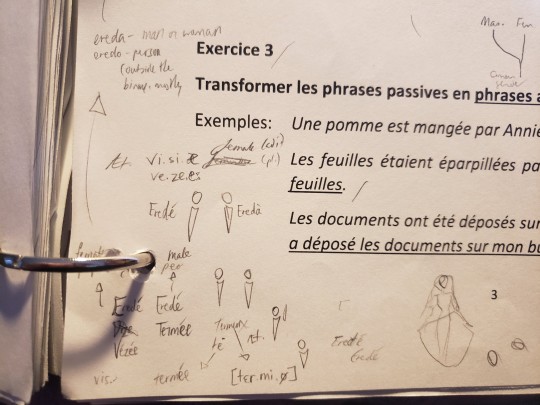
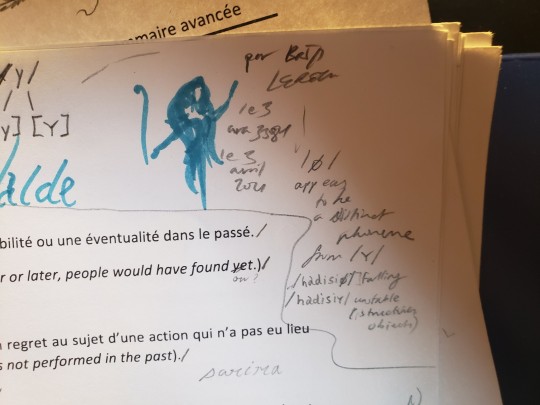
Transcription of text in photo 1 (Èrtuné notes):
ereda- man or woman
eredo- person (outside the binary, mostly)
eredé vézée (female people)
eredé termée (male people)
Æt. /vi.si.e./ (female; plural adj.)
[Ètu.] /ve.ze.eː/
[Note: it would actually be pronounced /vɪ.ze.eː/ instead, and spelled vyzée. Near the start of the Middle Ætani period, /ɪ/ was sometimes lengthened to /ɪː/.
Eventually, /ɪ/ and /ɪː/ merged with /i/ and /iː/ respectively, which resulted in the pronunciation of viteu (alive, m.s.) going from /vɪtiu/ in Old Ætani to /vitiʏ/ in Middle Ætani. Likewise, Old Ætani lyn /lɪːn/ (earth) became Middle Ætani līn /liːn/. Such innovations applied to the Viseleav branch and Sarīna only.]
Photo 2:
/ø/ appears to be a different phoneme from /ʏ/ [at least one minimal pair can be formed:
/hadisiø/ [hadisiu], falling [gerund of hadir, to fall]
/hadisiʏ/ [hadiseu], unstable (structures, objects) [adj. in masculine gender and singular number]
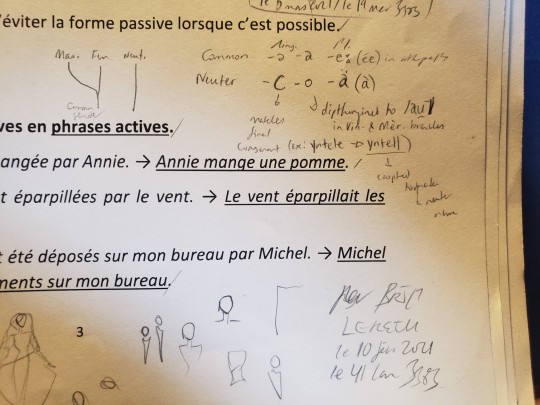
Transcription (photo 3; notes on Èrtuné):
Sing. Pl
Common gender : /-ə/ /-a/ /-eː/ (ée) in orthography
Neuter: /-C/ /-o/ /-ä/ (à)
[-C] matches final consonant (ex: yntele → yntell), [the latter being] coopted to make a neuter name.
[-o is] dipthongised [I spelled it wrong; I meant to say diphthongised] to /au̯/ in Vis. and Mèr. branches
#conlang#languages#pronunciation#phonology#phonetics#ade#diachronic stuff#sound changes galore#notes#i think i was supposed to study
0 notes
Text
Ara (née Q’aditt; pronounced /qʼädɪt/)

The first Universe Mother, known to her Amlita-speaking descendants as Ara (which in Ætani simply means “universe,” “emptiness” or “space,”) was born over eight hundred million years PK back during the Alīna Astkīvite, a period where the seventeen elements that made up alīna, or existence, were all controlled or, in the case of fate, merely seen by a group of 17 deities called the primæval elders who had been fighting something resembling a war of attrition for æons.
A bit over two thousand years before her birth, two of those elders, known as Fer and Sari in most Amlita tongues but in their own time as /ʋɑ̃ɖɪ/ and /ɬɯɾvəs/ respectively, had fallen in love, married and realised that they were sick of the constant fighting. To their fellow elders, they proposed a solution: a child in whom the entirety of existence was united, and descended from all of the elders.
For some reason, they agreed to this plan and in around a couple millennia, Ara, or Q’aditt as she was known during her first few thousand years, was born. Five hundred or so Earth years after that, she used her powers to destroy pretty much everything except for herself, giving rise to the Era of a United Existence, or krathe (ille) alīnlare meralite, which lasted until the death of her 21st great-granddaughter in 444 PK. In a way, she kind of did end the war, just...probably more violently than Fer and Sari were expecting....
0 notes